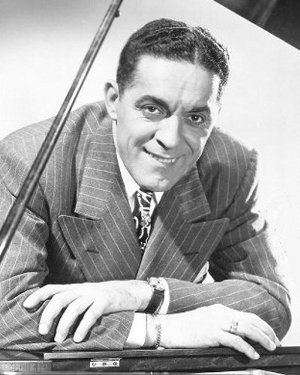Frankie Carle

-
Birth Name
Francis Nunzio Carlone -
Born
March 25, 1903
Providence, Rhode Island -
Died
March 7, 2001 (age 97)
Mesa, Arizona -
Featured Vocalists
Paul Allen
Betty Bonney
Phyllis Lynne
Pianist and bandleader Frankie Carle’s career spanned almost seventy years. His first professional job came in 1916, working in his uncle’s band for a dollar a week. He briefly led his own outfit in 1920 before joining Edwin J. McEnelley in 1921, with whom he made his first recordings.
In 1936, Carle joined Mal Hallett. When Hallett’s band broke up in 1937, Carle led his own regional outfit around New England. His big break came in 1939 when he joined Horace Heidt. Gaining exposure on Heidt’s national radio program, Carle quickly became popular for his piano style and found himself in big demand. In 1941, a recently drafted Eddy Duchin asked Carle to take over his orchestra for twenty five percent of the gross while he was away. When Carle mentioned it to Heidt, Heidt offered Carle a thousand dollars a week plus five percent of the gross. Carle stayed on with Heidt. While with Heidt, he also made solo piano recordings.
As Bandleader
In October 1943, Carle left Heidt and headed to the West Coast to organize his own orchestra. The band went east after the first of the year to make its debut in February 1944 at the Hotel Pennsylvania in New York, with Betty Bonney joining them as vocalist. She remained with the band until May, with Phyllis Lynne replacing her. Lynne passed up a contract offer from 20th Century Fox in August to remain with the band. Musicians Lee Columbo and Roger Bacon sang until balladeer Paul Allen joined in mid-1944.
Lynne left in September 1945, replaced by Marjorie Hughes. Hughes was actually Carle’s daughter. When Carle was searching for a new vocalist, his wife slipped Marjorie’s recording into the stack of demos, and Carle unknowingly choose her. He changed her name so as to let her build her own reputation, but gossip columnist Walter Winchell let the secret out after her first big hit, “Oh, What It Seemed to Be.” Allen remained until March 1946. Gregg Lawrence took his place. Both Hughes and Lawrence stayed with the band until its demise. Marianne Dunne also sang with the band at some point between May 1947 and September 1948.
Carle’s group charted several hits for Columbia during the 1940s and appeared on two radio programs, remaining active until 1950, when Carle formed a slimmed-down unit. Known as Frankie Carle and His Rhythm, the group consisted of Carle on piano with four female musicians on guitar, drums, accordion and bass. The combo played smaller halls and recorded for RCA. Carle semi-retired during the 1960s but became active again during the big band revival of the 1970s. Carle’s last tour was in 1983. He retired to Mesa, Arizona, to be near his daughter. Carle passed away in 2001, just 18 days shy of his 98th birthday.
Vocalist Timeline
Note: Dates may be approximate. Some vocalists may not be listed due to lack of information on their dates of employment.
Sources
- Simon, George T. The Big Bands. 4th ed. New York: Schirmer, 1981.
- “Frankie Carle Leaves Heidt To Form Band.” Down Beat 1 Oct. 1943: 12.
- “Frankie Carle Set for Penn.” Down Beat 1 Jan. 1944: 5.
- “Frankie Carle In NYC Bistro.” Down Beat 15 Feb. 1944: 1.
- “On the Stand: Frankie Carle.” Billboard 26 Feb. 1944: 16.
- “Bands Dug by the Beat: Frankie Carle.” Down Beat 1 Apr. 1944: 3.
- “Music Grapevine.” Billboard 27 May 1944: 99.
- “Car Strike Cuts Carle Gross.” Billboard 12 Aug. 1944: 28.
- “Music Grapevine.” Billboard 19 Aug. 1944: 16.
- “Heat Chills San Fran Take.” Billboard 30 Jun. 1945: 34.
- “Vaudeville Reviews: Oriental, Chicago.” Billboard 22 Sep. 1945: 35.
- “Music as Written.” Billboard 6 Apr. 1946: 22.
- “Marriages.” Billboard 13 Apr. 1946: 85.